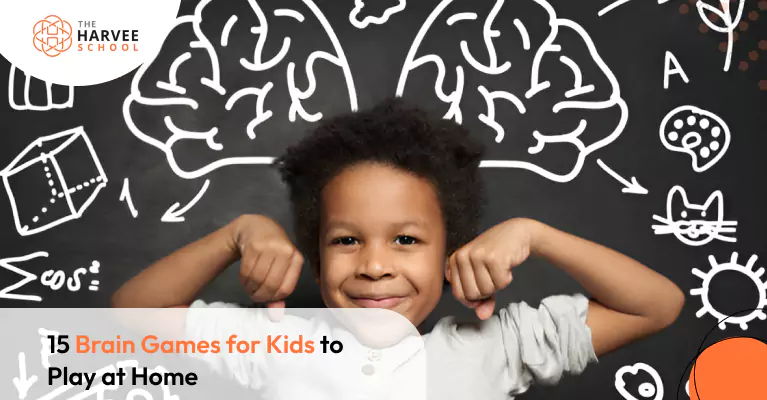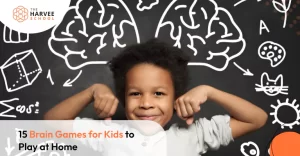15 Brain Games for Kids to Play at Home
Just like climbing frames helps in building muscle, brain games exercise our “mental muscles” that power attention, logic, and creativity. Neuroscientists call this neuroplasticity; the brain’s ability to re-wire itself through challenge and repetition. Studies show that short, targeted cognitive activities can:
- Strengthen working memory and processing speed
- Improve classroom attention spans
- Nurture problem-solving confidence
- Foster a growth mindset (“I can figure this out!”)
Below you’ll find 15 expert-approved, screen-light activities you can set up in minutes. Each entry lists the core skill, materials, quick how-to, and a pro tip so you can tailor difficulty for ages 4–12. Rotate two or three games each week; variety engages multiple brain regions and keeps enthusiasm high.
1. Memory Card Flip
This classic game strengthens working memory and concentration. All you need is a set of picture card pairs—think animals, shapes, or vocabulary images. Lay them face down in a grid and take turns flipping two cards at a time, trying to find matches. It’s a simple yet powerful way to boost recall skills.
Pro Tip: Time each round and encourage kids to beat their previous record. This turns memory-building into a fun personal challenge.
2. Simon Says – Brain-Boost Edition
Upgrade the traditional “Simon Says” game to target auditory processing and impulse control. Use commands like, “Simon says hop to the nearest triangle” or “Touch something that begins with the letter B.” These variations require kids to listen carefully and act with intent.
Pro Tip: Let kids take turns being “Simon.” It boosts leadership, verbal skills, and helps reinforce directions in a fun, active way.
3. DIY Crossword Puzzles
Enhance vocabulary and spelling skills with crossword puzzles tailored to your child’s weekly spelling list. Use free puzzle generators online, or encourage older children to create their own crosswords for younger siblings great for peer learning.
Pro Tip: Turning puzzle-making into a sibling activity develops teamwork and boosts comprehension for both the creator and the solver.
4. Junior Sudoku
Introduce logic and number sense with beginner-friendly 4×4 or 6×6 Sudoku puzzles. These simplified versions are perfect for younger kids to build strategic thinking.
Pro Tip: For pre-readers, replace numbers with stickers or colors. It adds a playful visual element while preserving the logic challenge.
5. Tangram Picture Challenge
Tangrams teach spatial awareness by challenging kids to recreate silhouette cards using seven geometric pieces. Whether printed or made from cardboard, these puzzles are great for tactile learning.
Pro Tip: Add a timer and let kids track personal bests. A visual leaderboard on the wall boosts motivation and celebrates small wins.
6. Story Sequencing Cards
Develop narrative thinking by giving children sets of 3 to 6 story cards. Mix them up and ask your child to reorder them logically and then retell the story in their own words. It enhances comprehension, language development, and the concept of cause and effect.
Pro Tip: Encourage your child to come up with an alternative ending. This not only sparks creativity but also builds storytelling confidence.
7. Chess Mini-Matches
Chess isn’t just for grown-ups, it’s fantastic for developing strategic planning and foresight in kids. Begin with a simplified version like “Pawn Wars,” using only pawns and kings. Add more pieces as their understanding deepens.
Pro Tip: Use child-friendly chess apps or pieces for additional solo practice between matches. The game will sharpen their ability to think ahead.
8. Spot-the-Difference Races
This fast-paced visual discrimination game involves finding subtle differences between two similar images. Set a timer two minutes long and see how many differences your child can spot.
Pro Tip: Laminate the pages and use dry-erase markers so kids can reuse the same puzzles and track their progress over time.
9. Lego Pattern Coding
Turn playtime into an intro to computational thinking with Lego blocks. Build and extend patterns using color or shape sequences. As your child improves, add “if-then” logic like, “If you see red, stack two blue blocks.”
Pro Tip: These coding basics lay the groundwork for later programming skills, all while playing with their favorite toys!
10. 20 Questions
A classic game that teaches deductive reasoning and strengthens oral communication. One child thinks of a mystery object, while others ask up to 20 yes/no questions to figure out what it is.
Pro Tip: Restrict the category to animals, food, or objects to help younger kids focus their thinking and avoid overwhelm.
11. Math Bingo
This spin on traditional Bingo helps develop mental math speed and accuracy. Replace Bingo numbers with simple equations, such as “5 + 4” or “12 ÷ 3.” Players must solve problems to find the right spots on their boards.
Pro Tip: Mix in addition, subtraction, and even fractions to suit different skill levels and keep it exciting.
12. Printable Maze Marathon
Mazes support fine-motor skills, planning, and perseverance. Print a series of mazes that gradually increase in difficulty. Let kids work through them in a “marathon” format, tracking how quickly they finish each one.
Pro Tip: Use a different color to trace wrong turns. Reviewing mistakes helps kids understand problem-solving and develop persistence.
13. Treasure-Hunt Riddles
This active and collaborative game challenges kids to solve riddles or mini-puzzles to find the next clue. You can hide clues around the house or garden, turning learning into an adventure.
Pro Tip: Include educational content in the clues like a science fact or a history question so your kids learn without even realizing it.
14. Jigsaw Puzzle Relay
Perfect for teams, this game develops pattern recognition and collaboration. Divide a large educational puzzle like a map or solar system into sections and have small teams complete their part as quickly as possible.
Pro Tip: Halfway through, swap puzzle sections between teams. This twist teaches flexibility and teamwork under pressure.
15. Rubik’s Cube for Beginners
Introduce your child to algorithmic thinking with a 2×2 or 3×3 Rubik’s Cube. Start small by teaching the “white cross” and gradually progress toward solving layers.
Pro Tip: Celebrate each milestone, solving one layer, then two to keep kids motivated and proud of their problem-solving progress.
Science Behind the Fun
When kids solve a maze or work on a crossword puzzle, a part of their brain called the prefrontal cortex becomes active. This helps build brain connections that support important skills like planning, focusing, and doing more than one task at a time.
Regular mental workouts also boost dopamine, the “reward” neurotransmitter, making learning feel inherently satisfying.
How to pick the right brain game for your child?
Match Age & Skill Level – A 4-year-old may thrive on memory cards, while a 10-year-old might crave Sudoku.
Blend Learning Styles – Use tactile tangrams for kinesthetic learners, verbal riddles for word lovers.
Keep Sessions Short – 15–20 minutes, 2-3 times per week, maximises engagement without overload.
Celebrate Effort – Sticker charts, high-fives, and “personal best” shout-outs cultivate a growth mindset.
Conclusion
From flipping memory cards to cracking Rubik’s cube algorithms, these 15 brain games turn spare moments into skill-building adventures.
Introduce them into family nights or classrooms and you’ll nurture curiosity, resilience, and a lifelong love for learning.
Start with one game tonight and watch your child’s confidence grow day by day.
Frequently Asked Questions
Memory Card Flip, Simon Says, and Tangram challenges need minimal setup and materials you already own.
Two or three 15-minute sessions per week give measurable gains in focus and problem-solving within a month.
They don’t boost IQ scores overnight, but they sharpen executive function skills that translate to better academic performance and social decision-making.






